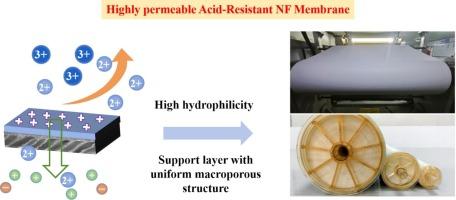用于冶金废酸处理的高渗透耐酸纳滤膜:结构-性能关系和选择分离机制
IF 9.8
1区 工程技术
Q1 ENGINEERING, CHEMICAL
引用次数: 0
摘要
耐酸纳滤(NF)膜在冶金废酸处理中具有广阔的应用前景;然而,它们的实际部署往往受到有限的透水性的限制。在这项研究中,我们系统地研究了一种高渗透性的酸稳定NF膜(ASNF),重点研究了它的结构-性能关系、分离机制和操作适用性。由于ASNF膜具有中等孔径、较薄的选择层、较强的亲水性和高多孔的指状支撑结构,ASNF膜具有9.80 L m−2 h−1 bar−1的高透水性。值得注意的是,它的高表面正电荷(在中性pH下~10 mV)与中等孔径相结合,使得氯化镁的截留率(> 98%)非常出色,有效地克服了耐酸NF膜中离子截留和渗透性之间的典型权衡。ASNF在渗透性和阳离子选择性方面优于商业膜和文献报道的膜。在20%硫酸、盐酸和磷酸中也表现出极好的化学稳定性,暴露30天后性能损失可以忽略不计。在盐酸体系中,增强的静电排斥和共离子竞争导致优越的阳离子选择性,而硫酸盐离子可能减少由于静电吸引而产生的阳离子排斥。盐的排斥性受ph依赖离子形态形成和静电相互作用以及不同盐浓度下的离子竞争和电荷屏蔽的影响。该膜还具有很强的抗污性和可扩展性。1812型ASNF模块在锂渣渗滤液低压操作下表现出高离子选择性,具有工业应用潜力。本文章由计算机程序翻译,如有差异,请以英文原文为准。

Highly permeable acid-resistant nanofiltration membranes for metallurgical spent acid treatment: Structure–performance relationships and selective separation mechanisms
Acid-resistant nanofiltration (NF) membranes hold great promise for the treatment of metallurgical waste acids; however, their practical deployment is often constrained by limited water permeance. In this study, we systematically investigate a highly permeable acid-stable NF membrane (ASNF), focusing on its structure–property relationships, separation mechanisms, and operational suitability. The ASNF membrane achieves a high water permeance of 9.80 L m−2 h−1 bar−1, attributed to its moderate pore size, thin selective layer, strong hydrophilicity, and highly porous finger-like support structure. Notably, its high positive surface charge (~10 mV at neutral pH) combined with the moderate pore size enables an exceptional rejection of magnesium chloride (>98 %), effectively overcoming the typical trade-off between ion rejection and permeance in acid-resistant NF membranes. ASNF outperforms commercial membranes and those reported in the literature in both permeance and cation selectivity. It also shows excellent chemical stability in 20 % sulfuric, hydrochloric, and phosphoric acid, with negligible loss in performance after 30 days of exposure. In hydrochloric acid systems, enhanced electrostatic repulsion and co-ion competition lead to superior cation selectivity, whereas sulfate ions may reduce cation rejection due to electrostatic attraction. Salt rejection is influenced by pH-dependent ion speciation and electrostatic interactions, as well as by co-ion competition and charge shielding at varying salt concentrations. The membrane also exhibits strong antifouling resistance and scalability. An 1812-type ASNF module demonstrated high ion selectivity under low-pressure operation in lithium slag leachate treatment, underscoring its potential for industrial applications.
求助全文
通过发布文献求助,成功后即可免费获取论文全文。
去求助
来源期刊

Desalination
工程技术-工程:化工
CiteScore
14.60
自引率
20.20%
发文量
619
审稿时长
41 days
期刊介绍:
Desalination is a scholarly journal that focuses on the field of desalination materials, processes, and associated technologies. It encompasses a wide range of disciplines and aims to publish exceptional papers in this area.
The journal invites submissions that explicitly revolve around water desalting and its applications to various sources such as seawater, groundwater, and wastewater. It particularly encourages research on diverse desalination methods including thermal, membrane, sorption, and hybrid processes.
By providing a platform for innovative studies, Desalination aims to advance the understanding and development of desalination technologies, promoting sustainable solutions for water scarcity challenges.
 求助内容:
求助内容: 应助结果提醒方式:
应助结果提醒方式:


